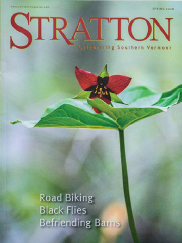Life here in Vermont seems, on the one hand, civilized and sophisticated. We have our justly famous bookstore and our stores with recognizably urban names, our music festivals and our famous theatres. But if you live here, you can also be enjoying your morning coffee on the deck, look up, and see a bear ambling across your back yard. The wildness and the striking beauty of nature is never very far away. You merely need to lift up your eyes unto the hills and their thousands of wooded acres to see it.
We have been celebrating the beauty and diversity of our natural environment for fifty years now. Sometimes, as in our treatment of what we called The Vermont Everglades, this means getting off the main road and back in to places where most people never go, but often wonder about.
We have sent our writers out to other special places to include the White Rocks, a sort of local El Dorado for students of geology, then to visit a preserve where the the massive and stately 300-year-old virgin Canfield Fisher Pines grow. And we have, of course, celebrated the way our hardwoods dazzle us with their annual display of colors that don’t seem to occur quite so vividly anywhere else.
Wild country is home to many creatures and we have made our readers familiar both with the animals that they see routinely, but don’t really know, and those that seldom reveal themselves. We have covered the coyotes, that most of us know only by their haunting, nocturnal calls and we have covered the ubiquitous whitetail deer in Ed Barna’s article The Cult of the Deer, exploring their important cultural and ecological niche.
We have published articles on the life and lore of nature’s consummate engineer—the beaver—testifying to his legendary business and the way he has made this place look the way it does.We have published stories about the remarkable comeback of the moose in Vermont and on the disappearance and often rumored reappearance of the mountain lion, aka catamount. Recently, we sent Geoffrey Norman along with a wildlife biologist who was conducting a study of timber rattlesnakes which are endangered in Vermont. Norman has also written for us about more abundant and less lethal wildlife, to include the songbirds we feed and the crows that, it sometimes seems, will not shut up.
The wild side of the Northshire is endlessly engaging to those of us who live here. We have hunted mushrooms with Jim Lepage, an expert. And we have admired the wildflowers and the life forms found in our vernal ponds. We have worried over the plight of the monarch butterfly and wondered over the legend of the wooly bear caterpillar. (Can he really predict the weather?)
We live in the country so we celebrate country living. All of it. To include the birds of the air and the beasts of the field.


